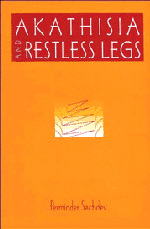Book contents
- Frontmatter
- Contents
- Foreword
- Acknowledgements
- Abbreviations
- Part I Introduction
- Part II Drug-induced akathisia
- 4 The definition of drug-induced akathisia
- 5 Epidemiology
- 6 Clinical characteristics and diagnosis of acute akathisia
- 7 Clinical characteristics of tardive and chronic akathisia
- 8 Akathisia due to a general medical condition
- 9 Assessment and measurement of akathisia
- 10 Aetiology and pathogenesis of akathisia
- 11 Treatment of drug-induced akathisia
- Part III Restless legs syndrome
- Part IV Conclusions
- Appendix A Haskovec's Akathisie
- Appendix B Prince Henry Hospital Akathisia Scale
- Appendix C Barnes (1989) Akathisia Rating Scale
- Appendix D Hillside Akathisia Scale (version 4)
- References
- Index
4 - The definition of drug-induced akathisia
from Part II - Drug-induced akathisia
Published online by Cambridge University Press: 12 September 2009
- Frontmatter
- Contents
- Foreword
- Acknowledgements
- Abbreviations
- Part I Introduction
- Part II Drug-induced akathisia
- 4 The definition of drug-induced akathisia
- 5 Epidemiology
- 6 Clinical characteristics and diagnosis of acute akathisia
- 7 Clinical characteristics of tardive and chronic akathisia
- 8 Akathisia due to a general medical condition
- 9 Assessment and measurement of akathisia
- 10 Aetiology and pathogenesis of akathisia
- 11 Treatment of drug-induced akathisia
- Part III Restless legs syndrome
- Part IV Conclusions
- Appendix A Haskovec's Akathisie
- Appendix B Prince Henry Hospital Akathisia Scale
- Appendix C Barnes (1989) Akathisia Rating Scale
- Appendix D Hillside Akathisia Scale (version 4)
- References
- Index
Summary
The greater the ignorance the greater the dogmatism.
Sir William Osler, Montreal Medical Journal (Sept. 1902, p. 696)While the importance of akathisia as a side-effect of the first-generation neuroleptics and some other drugs is now well recognized, there exists no consensus on its essential characteristics and hence its diagnostic criteria. If we are to discuss its epidemiology and pathophysiology, we must first clearly state, and agree upon, the definition of drug-induced akathisia (DIA). As no generally accepted diagnostic criteria exist, the diagnoses reported in the literature are usually based either on rating scales designed to measure the severity of akathisia (Barnes, 1989; Fleischhacker et al, 1991) or on psychiatrists' clinical opinions. The criteria for TA used by Burke et al (1989) are a rare exception. The problem of variable definitions of akathisia was highlighted by Stahl (1985) and has been reiterated by many subsequent reviewers (Burke and Kang, 1988; Adler et al, 1989b; Lees, 1990; Sachdev and Loneragan, 1991a; Lang, 1992). This chapter discusses the reasons for the difficulties encountered and outlines a proposal for the research diagnostic criteria for DIA published by Sachdev (1994a). A less detailed proposal by Lang (1994) will also be discussed. In this and the following chapters, the term akathisia will refer to drug-induced akathisia, and DIA or neuroleptic-induced akathisia (NIA) will be used only when the actiological importance of drugs, or specifically neuroleptics, must be highlighted.
A number of issues can be identified that have led to the confusion with regard to definition.
- Type
- Chapter
- Information
- Akathisia and Restless Legs , pp. 63 - 84Publisher: Cambridge University PressPrint publication year: 1995



